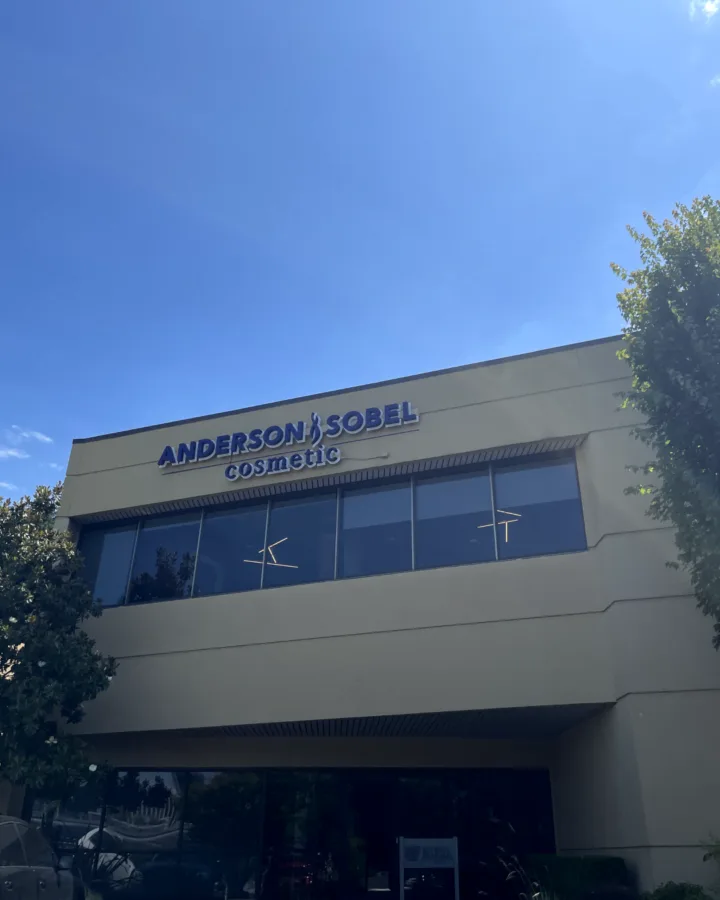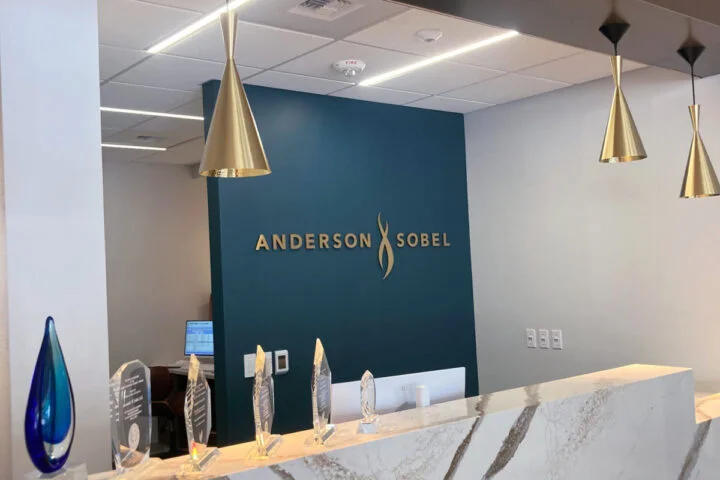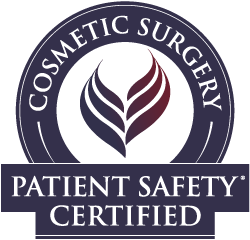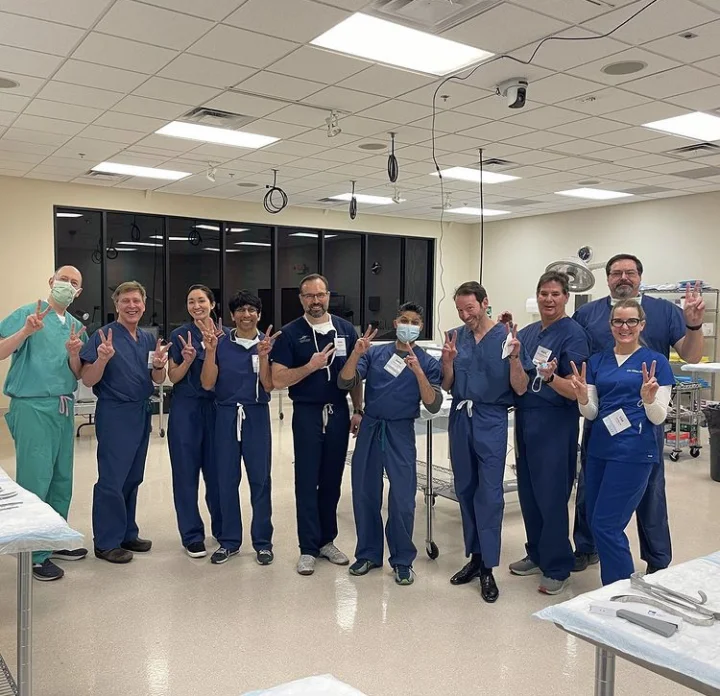Breast Reduction: Reduce your breast size to relieve back pain and restore a youthful appearance
If you’re one of the many women who feel uncomfortable with having large breasts, we highly recommend considering breast reduction Bellevue: it is one of the most highly rated plastic surgery procedures. Seattle & Bellevue breast enhancement patients can explore their options with triple board certified cosmetic surgeon Dr. Alexander Sobel and a patient concierge at Anderson Sobel Cosmetic Surgery—we’ll listen to your concerns and propose solutions to help you feel more comfortable in your body. Breast reduction results not only improve the aesthetics of the body but can also give a patient a greater sense of confidence and comfort, relieving pain in the neck, back, and shoulders.
- Triple board-certified in general cosmetic surgery, facial cosmetic surgery, and otolaryngology
- 15+ years of experience specializing in cosmetic surgery
- Operates in an on-site accredited surgical suite for patient safety and privacy
- National leader in cosmetic surgery, including as Past President of the American Board of Cosmetic Surgery and the American Academy of Cosmetic Surgery, and as an expert speaker at medical conferences
- Former Seattle Met Top Doctor with hundreds of 5-star patient reviews
Why Do Women Seek Reduction Procedures?
There are several reasons for choosing breast reduction, also known as reduction mammaplasty. When the body looks imbalanced or disproportionate, it can affect a woman’s self-confidence. Large breasts also make many women feel uncomfortable in social situations. That said, most women are looking beyond aesthetic benefits when they decide to undergo breast reduction surgery: extremely large breasts often cause back problems and discomfort.
Removing the extra weight helps lift the posture for much-needed relief from the discomfort caused by heavy breasts, helping patients experience normal life in much greater comfort. Additionally, smaller breasts allow a wider range of clothing sizes and styles.
How is a Breast Reduction Performed?
Dr. Sobel uses the most advanced reduction techniques to tailor your surgery for the best breast reduction results possible.
Incision Techniques
Every breast reduction surgery we perform is as unique as our patients. Dr. Sobel will determine which surgical technique will best achieve your goals based on your individual anatomy, the extent of reduction desired, and personal preferences. Possible incision techniques include:
The “anchor” incision
This type of incision is the most common and allows Dr. Sobel to dramatically reduce excess breast tissue, leaving behind three scars: around the nipple, along the outline of the areola (nipple-areolar complex), one that extends down from the areola, and a third along the natural crease under the breast
The vertical or “lollipop” technique
This incision can be used if you desire only a modest reduction in breast tissue. With this technique, you will only have a scar around the areola and a vertical scar down the bottom portion of the breast. You will not have a scar in the inframammary fold (the natural crease where your abdomen and breast meet).
What to Expect During Your Reduction Mammaplasty Consultation
We are here to help women consider their goals carefully. It starts with a breast reduction Bellevue consultation to discuss your needs and expectations. First, Dr. Sobel will go through your reasons for wanting to pursue plastic surgery to reduce the size of your breasts. Then, with another staff member present, Dr. Sobel will examine your breasts. From there, Dr. Sobel can help you decide the most appropriate breast size for your body. Dr. Sobel will design a detailed surgical plan to suit your exact needs and explain his plans to you, and then you will receive a fee quote. We’ll also help you with payment options. In sum, Dr. Sobel and your patient concierge will help you feel comfortable and informed throughout the process!
Video transcript
Mastopexy (breast lift) and reduction mammoplasty (breast reduction) are terms that can be as confusing as the incisions that make them happen. The incisions are important not just because of the scars—of course, no one wants scars, especially in cosmetic surgery where we aim to optimize outcomes and make it look like we were never there. But what’s particularly interesting is how the design of the incisions actually shapes the breast.
For example, in vertical mastopexy techniques, you often hear terms like “teardrop,” “keyhole,” or “lollipop.” These terms refer to roughly the same procedure, where the goal is not to pull the breast down, as you might pull a shirt over pants, which can result in a boxy or squared breast and a long scar under the breast fold. Instead, if we aim for a teardrop, conical, and projected shape, a simpler vertical incision up and down can achieve that. The final scar is just a line, but what it represents is the removal of tissue—sometimes described as a “snowman” shape—where the wide base of the breast can be gathered to create projection and a teardrop shape.
It’s not enough to do this just with the skin. What’s far more important is reshaping the breast tissue underneath. For most women, age, pregnancy, and breastfeeding cause the fat and volume to disappear from the upper part of the breast and accumulate in the lower part. To correct this, we need to remove the heavier tissue that’s weighing down the breast, and reconstruct a supportive brassiere-like structure underneath to hold the breast in a lifted, teardrop shape.
Historically, for many women, the only solution was a scar all the way across the bottom of the chest to lift the breast skin. However, this approach isn’t as reliable as removing tissue from underneath and allowing the skin to follow its natural design for the best results.
Who is an Ideal Candidate for Breast Reduction Surgery?
An ideal candidate for breast reduction is anyone experiencing discomfort or self-consciousness due to large breasts. Enlarged breasts are often genetic, or increase in size due to weight gain, pregnancy, or breastfeeding. It’s not uncommon for women to seek reduction surgery to restore more proportionate breasts that harmonize with the rest of their body, which has the added benefit of making it appear as though they’ve lost a considerable amount of weight. Oversized breasts can sometimes obscure the overall silhouette, making you appear heavier than you really are.
Candidates for major surgery should be in good health, non-smokers, and have stabilized breast growth.
What are the Benefits of Reducing Your Breast Size?
In many cases, women seek this type of breast surgery to make an active lifestyle more accessible. The weight of large breasts can cause several issues, including:
- Neck pain
- Back pain
- Shoulder pain
- Skin rashes
- Chaffing
Preparing for Your Reduction Surgery
Taking time to be fully prepared for surgery and recovery is key to minimizing risks and complications and seeing the best results as quickly as possible. Dr. Sobel will provide very detailed aftercare protocols for you to follow after surgery and during your breast reduction Bellevue recovery, but here are general recommendations:
- Have a partner or caregiver on hand to help you for at least the first 24-48 hours.
- Plan for childcare is needed, as you will not be able to lift anything over 5-10lbs for 6 weeks.
- Stock your fridge and pantry with nutritious meals and snacks to support optimal healing.
- Ensure your compression garment is comfortable. Swelling is expected after surgery, so you may want to have different-sized garments to try to find the best fit.
Breast Reduction Surgery with Dr. Sobel
This reduction surgery is performed under general anesthesia. Surgical plans generally include the removal of breast tissue but can also include liposuction to remove excess fat. Incisions will be made according to your personalized surgical plan. A breast lift can also help create a more youthful look for more mature patients. Once the procedure is complete, incisions will be closed and the patient will be fitted with compression bandages.
- Key Benefits
- Glossary
- Reduces neck, shoulder, and back pain
- Creates balanced body proportions
- Corrects misshapen breasts and breast asymmetry
- Improves quality of life
Areola: The areola is the pigmented area surrounding the nipple on the breast.
Breast Revision: Breast revision is a surgical procedure performed to correct or improve the results of a previous augmentation breast surgery, such as breast augmentation, reduction, or reconstruction.
Breast Reconstruction: Breast reconstruction is a surgical procedure to rebuild the shape and look of a breast.
Mastopexy: Mastopexy, commonly known as a breast lift, is a surgical procedure to raise and reshape sagging breasts.
Reduction Mammoplasty: Reduction Mammoplasty is a surgical procedure to reduce the size and weight of large breasts, often to alleviate discomfort or pain.
Bilateral Mastectomy: Bilateral Mastectomy is the surgical removal of both breasts, often performed as a preventive measure against or treatment for breast cancer.
Macromastia: Macromastia is a medical condition characterized by excessively large breasts, which can lead to physical and psychological discomfort.
Excision: Excision refers to the surgical removal of tissue.
Complications: Complications are unexpected problems or adverse events that can occur during or after a medical procedure.
Inframammary Fold: The inframammary fold is the natural crease under the breast where it meets the chest wall.
General Anesthesia: General Anesthesia is a medically induced, reversible state of unconsciousness, used during surgical procedures to prevent pain and discomfort.
Surgical Bra: A surgical bra is a specially designed bra worn after breast surgery to provide support and comfort during the healing process.
Body Image: Body image refers to a person’s perception, thoughts, and feelings about their own body and physical appearance.
Medical History: Medical history is a record of an individual’s past health conditions, treatments, allergies, and other relevant medical information.
Glandular Tissue: Glandular tissue is a type of tissue found in glands and the breasts, responsible for producing and secreting substances like hormones or milk.
Side Effects: Side effects are unintended and often undesirable effects that occur in addition to the intended effect of a medication or treatment.
Drainage Tubes: Drainage tubes are medical devices used post-surgery to remove excess fluid or blood from the body to aid in healing.
Top Surgery: Top Surgery refers to chest reconstructive surgeries, typically associated with female-to-male transgender patients, to create a more masculine chest appearance.
Hormone Replacement Therapy (HRT): HRT is a medical treatment involving the administration of hormones, typically estrogen and/or progesterone, to alleviate symptoms related to hormonal imbalances or deficiencies.
Breast Reduction Recovery
After the anesthesia wears off, the expected swelling may cause some discomfort; however, Dr. Sobel will prescribe pain medication to take as needed. About 2 weeks after surgery, you will feel close to “normal” as you continue healing, and you’ll likely notice the weight of your breasts is greatly reduced. This sensation will continue to improve as swelling goes down. You’ll be fully healed after about 4-6 weeks, and Dr. Sobel will clear you to resume certain activities at your follow-up appointments based on your progress.
Breast Reduction Results
Although there will be some initial swelling, you’ll see and feel a huge difference in the weight and size of your new breasts and these changes will improve as each week goes by. The final results of your surgery will be visible after 6-12 months.
Breast Reduction Surgery Scars
Regardless of which surgery technique is used in your breast reduction Bellevue procedure, Dr. Sobel meticulously places incisions to be as inconspicuous as possible and ensures each patient is well-informed on post-procedure recovery guidelines to minimize the appearance of scarring as much as possible. Surgical scars will continue to flatten and fade for up to 2 years following surgery, and your breast reduction scars will be easily concealed with clothing or a swimsuit.
What Results Can Breast Reduction Surgery Achieve?
Reduction procedures have a high patient satisfaction rate, with breast reduction boasting a 97% Worth It rating on Real Self. After breast reduction Bellevue surgery, most patients can expect to see several improvements such as:
- Less back, neck, and shoulder pain
- Improved posture and ability to engage in physical activities
- Enhanced self-esteem and body image
- Easier fitting into clothes and bras
For many women, breast reduction surgery is a new lease on life!
Combining Breast Reduction with Other Procedures
For more comprehensive body reshaping, breast reduction surgery is often combined with other body contouring procedures, including:
Breast Reduction Surgery FAQs
References »
W. Grant Stevens, David A. Stoker, Mark E. Freeman, Suzanne M. Quardt, Elliot M. Hirsch, Mastopexy Revisited: A Review of 150 Consecutive Cases for Complication and Revision Rates, Aesthetic Surgery Journal, Volume 27, Issue 2, March 2007, Pages 150–154, https://doi.org/10.1016/j.asj.2006.12.014.
Austin RE, Saheb-Al-Zamani M, Lista F, Ahmad J. Periareolar Augmentation-Mastopexy. Aesthetic Surgery Journal. 2019 Aug 22;39(9):953-965. doi: 10.1093/asj/sjz128.
Chiummariello S, Angelisanti M, Arleo S, Alfano C. Evaluation of the sensitivity after reduction mammoplasty. Our experience and review of the literature. Annali Italiani di Chirurgia. 2013 Jul-Aug;84(4):385-8.
Nomoto S, Ogawa R. Comma-Shaped Incision for Reduction Mammoplasty and Mastopexy. Journal of Nippon Medical School. 2021 Jun 30;88(3):258-261. doi: 10.1272/jnms.JNMS.2021_88-313.
Desouki MM. Reduction mammoplasty is beneficial in women with and without history of breast cancer. Womens Health (Lond). 2015 Jul;11(4):419-22. doi: 10.2217/whe.15.32.
Xia TY, Scomacao I, Duraes E, Cakmakoglu C, Schwarz G. Aesthetic, Quality-of-Life, and Clinical Outcomes after Inferior Pedicle Oncoplastic Reduction Mammoplasty. Aesthetic Plastic Surgery. 2023 Jun;47(3):905-911. doi: 10.1007/s00266-023-03257-7.
Jørgensen MG, Albertsdottir E, Dalaei F, Hesselfeldt-Nielsen J, Schmidt VJ, Sørensen JA, Toyserkani NM. Superomedial Reduction Mammoplasty Affects Patients’ Ability to Breastfeed in a Distinct Manner: A Multicenter Study of 303 Patients. Aesthetic Surgery Journal. 2021 Oct 15;41(11):NP1498-NP1507. doi: 10.1093/asj/sjab263.
Brown DM, Young VL. Reduction mammoplasty for macromastia. Aesthetic Plastic Surgery. 1993 Summer;17(3):211-23. doi: 10.1007/BF00636264.
Paruthy E, Kannan A, Pant A, Anand A, Das S, Sundaramurthi S. Prophylactic Antibiotics for Reduction Mammoplasty: Current Evidence and Future Considerations. Aesthetic Plastic Surgery. 2023 Jun;47(Suppl 1):77-78. doi: 10.1007/s00266-022-02956-x.
Sachs D, Szymanski KD. Breast Reduction. 2023 Jun 27. In: StatPearls [Internet]. Treasure Island (FL): StatPearls Publishing; 2024 Jan–. PMID: 28723003.
Hammond DC, Loffredo M. Breast reduction. Plastic and Reconstructive Surgery. 2012 May;129(5):829e-839e. doi: 10.1097/PRS.0b013e31824a2efc.
Crittenden TA, Watson DI, Ratcliffe J, Dean NR. Long-term outcomes of breast reduction surgery: A prospective cohort study. Journal of Plastic, Reconstructive, & Aesthetic Surgery. 2023 Apr;79:58-67. doi: 10.1016/j.bjps.2023.01.035.
Stephen P. Daane, W. Bradford Rockwell, Breast Reduction Techniques and Outcomes: A Meta-analysis, Aesthetic Surgery Journal, Volume 19, Issue 4, July 1999, Pages 293–303, https://doi.org/10.1053/aq.1999.v19.100635001
Purohit S. Reduction mammoplasty. Indian Journal of Plastic Surgery. 2008 Oct;41(Suppl):S64-79. PMID: 20174545; PMCID: PMC2825129.
Elfanagely O, Othman S, Rios-Diaz AJ, Cunning JR, Whitely C, Butler P, Fischer JP. A Matched Comparison of the Benefits of Breast Reduction on Health-Related Quality of Life. Plastic and Reconstructive Surgery. 2021 Oct 1;148(4):729-735. doi: 10.1097/PRS.0000000000008312.
Roje Z, Roje Z, Milosević M, Varvodić J, Mance M. Current trends in breast reduction. Collegium Antropologicum. 2012 Jun;36(2):657-68.
Andrades P, Prado A. Understanding modern breast reduction techniques with a simplified approach. Journal of Plastic, Reconstructive & Aesthetic Surgery. 2008 Nov;61(11):1284-93. doi: 10.1016/j.bjps.2007.11.060.
DeLong MR, Chang I, Farajzadeh M, Nahabet EH, Roostaeian J, Festekjian J, Rough J, Da Lio AL. The Central Mound Pedicle: A Safe and Effective Technique for Reduction Mammaplasty. Plastic and Reconstructive Surgery. 2020 Oct;146(4):725-733. Doi: 10.1097/PRS.0000000000007173.
Simpson AM, Donato DP, Kwok AC, Agarwal JP. Predictors of complications following breast reduction surgery: A National Surgical Quality Improvement Program study of 16,812 cases. Journal of Plastic, Reconstructive & Aesthetic Surgery. 2019 Jan;72(1):43-51. doi: 10.1016/j.bjps.2018.09.002.
To learn more about breast reduction surgery, we encourage you to contact us online for a free consultation with Dr. Sobel.
Areas served:

Medically reviewed by Dr. Alexander Sobel — Updated on Apr 3, 2025












